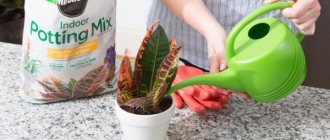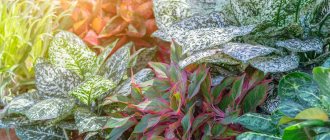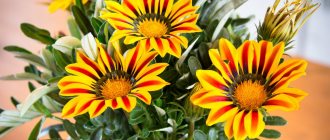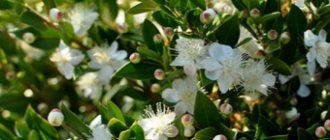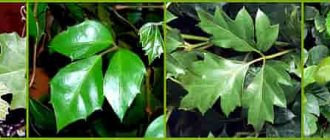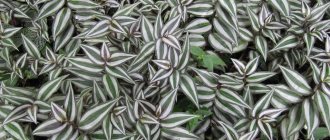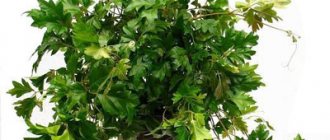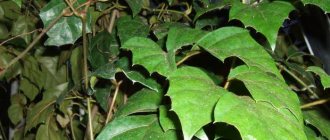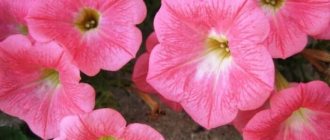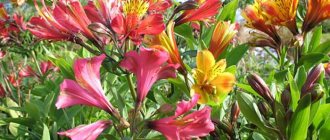Indoor flowers: photos and names in alphabetical order
In catalogs, indoor flowers with photographs and names are usually arranged alphabetically, their homeland, requirements and other data are indicated. We propose to get acquainted with groups of indoor plants and several of their prominent representatives.
Indian onion
Medicinal indoor onions have many names. You can recognize it by its wide leaves and large scaly bulb.
Hell root can replace a whole list of medications, but be careful, it is a very poisonous plant, so it can only be used externally.
It treats skin diseases and joint diseases well.
If you suffer from headaches , then regularly lubricate your temples with the juice of mature herbs. They say that the pain immediately subsides.
If you are suffering from radiculitis or rheumatism , then take the leaves of the plant, rub it well, lubricate the affected area, and wrap it in a scarf. Leave for 2 hours. You will feel a tingling sensation at first, but it will pass quickly.
Mucus can be used to lubricate herpes, warts, abscesses, cuts, tumors, and mastitis can be treated with compresses. In addition, Indian onions bloom beautifully, purifying the air from harmful bacteria. Look at the photo of the flowering plant.
Beautifully blooming indoor flowers with photos and names
This group is the favorite for many gardeners. Bright colors of flowers, a wide variety of plants, it’s easy to choose a flower that will fit perfectly into the conditions of the apartment. Representatives of this group have certain requirements for habitat and care. For successful flowering, such plants require fertilizer with the optimal composition, so use fertilizer marked “For flowering plants.”
Azaleas or Rhododendrons Sims (lat. rhododendron simsii)
These are small shrubs strewn with bright large flowers. The foliage is dark green in color, the leaves are pubescent on the underside, and have a dense leathery covering on the front. The small leaves very favorably set off the magnificent white, red, pink, and sometimes two-color buds. The flower petals can be double or simple, but they are all quite large in size.
Azalea requires bright light, but allows partial shade. Abundant watering is needed during flowering at intervals of 2-3 days. In other periods, it is enough to water the flower up to twice a week. The optimal temperature does not exceed 15 degrees.
ADVICE!
It is better to place the azalea on a tray of gravel and keep it moist. Flowers must not be wetted!
Rhododendrons do well in heather soil and in a shallow, wide container. Non-lime fertilizer should be applied once a month. Azaleas live up to 7 years if they are well cared for and taken out onto the veranda during the dormant period. But the life of this riot of colors in the apartment is limited to a few weeks.
Rhododendron: what kind of flower is it? In a special publication on our portal, we will tell you in detail about this unusual flower, what types it comes in, what beneficial properties it has, how to properly grow, propagate, feed and prune.
Anthurium (lat. anthurium)
Popularly called “male happiness” or “tongue of fire”. The plant is a perennial, blooming red all year round. The inflorescence can be pink, yellow, white, always in the form of a cob. Heart-shaped leaves of dark green color on long petioles reach 40 cm. The height of the plant ranges from 40 to 80 cm, growing half a meter in width.
A man's happiness lasts for 3 years, then the leaves fall. To make the flower comfortable, partial shade or diffused light is required in the complete absence of drafts. Watering is carried out once every 4 days, fertilizing is carried out every three weeks during the warm period of the year.
ADVICE!
Anthurium needs to be sprayed daily and at the same time manage not to get any drops on the inflorescence.
Special requirements: at temperatures below 10˚C, the leaves turn yellow and fall off. To make hibiscus bloom better, trim their stems in March, leaving only 2 eyes on each.
Gloxinia (lat. sinningia)
It is a flowering plant that reproduces by tubers. If you are unfamiliar with this plant, bought it, admired its beautiful large gramophone flowers from April to August, and then suddenly the plant disappeared and dried up - don’t rush! The peculiarity of gloxinia is such that when it fades, it will most likely retire, leaving nothing but bare earth as a reminder of itself. Meanwhile, the tuber will undergo an important life period. The soil is suitable deciduous heather with humus.
Gloxinia leaves are beautiful in themselves: long, up to 20 cm, with delicate fluff and edges resembling scallops, they are arranged in a rosette. The plant itself does not exceed 30 cm in height.
The flower responds favorably to diffused sunlight, but it does not like direct sunlight.
There is no need to waste time on spraying - it is contraindicated for leaves. And you need to water the beauty once every three days by lowering the pot into settled water at 22-25 degrees for 10-15 minutes.
IMPORTANT
The earth ball should not dry out completely between waterings!
From the end of September, watering is reduced, and after the leaves fall until new shoots appear, the plant is not watered.
Narrow-leaved nolina
The nolina plant is also called bocarnea, has narrow long leaves, is unpretentious, and therefore is well suited for growing at home. In order for the flower to be lush and healthy, you must follow the basic rules for caring for it. The soil does not need to be watered heavily, as this can lead to rotting of the root system.
Periodically trim dry leaves or their ends. Bocarnia can be planted in universal flower soil; in some cases it is mixed with coarse sand, so the plant feels more comfortable. To ensure active growth of the bush, in winter it is left alone, keeping the temperature at least 10 degrees, and the air is slightly cool and dry.
In summer, the flower is demanding of lighting; it can even withstand direct sunlight; the pot can be taken out into the open air. The room temperature is maintained at 18 to 25 degrees, the plant is removed from drafts so that it does not die.
This plant likes to be in one place, so it is better not to move it; usually the container is placed on the south or southwest side. Young Nolina is replanted every year, and an adult plant - as the root system grows, when the entire container is filled with roots, usually this happens once every two years.
The soil mixture for growing should not be too heavy; for this, compost or turf soil, sand and humus are mixed in equal quantities; replanting is carried out with special care, since the roots are too fragile. After this, the plant is left alone, without even watering for up to three days.
Sun-loving, beautifully flowering indoor plants
To choose a place for indoor plants, it is sometimes useful to know where their homeland was. And if the flower came from the equatorial zone, but grew under the cover of the jungle, then it will easily tolerate shading. But if the plant’s homeland was an open sunny space, then without a daily dose of sunlight, success will not be achieved.
Let's look at the photo and learn more about some indoor plants that are lovers of sunbathing.
Primrose (lat. primula)
A perennial flowering plant with evergreen leaves up to 15 cm long. The foliage is corrugated and forms a rosette.
Bright primroses
The inflorescences are collected in umbrellas or solitary, the corollas are double or simple. There are varieties that combine a silvery coating on the petals and two-color petals or a bright core. There may be no smell.
In order for the flowering to be bright and long, it is better to choose the lightest place and water it in such a way that the soil is always moist. The leaves themselves cannot be watered.
It is better to place the pot on wet gravel. Primrose loves geranium soil and fertilizers.
IMPORTANT
After the plant has flowered, it is transferred to partial shade.
Fuchsia (lat. fuchsia)
They are evergreen or deciduous, erect or may have drooping stems.
The flowers resemble small, up to 8 cm, lanterns and are pleasing to the eye from mid-May until the first frost. Color range: white, pink, red, pink-lilac, purple, combining two colors. The leaves are oval, matte, located opposite on red stems. The edges of the leaves are serrated.
Magic fuchsias
The plant loves a certain amount of direct sunlight, so you need to place the pot where the sun shines in the first or second half of the day.
Watering depends on the air temperature, but the substrate should dry out between waterings. The plant is sprayed twice a week. Replanting is needed annually, and young plants need to be replanted several times a season into enriched garden soil with sand.
In summer, fuchsias are usually taken outside into some shade.
ATTENTION!
During flowering, fuchsia must not be rotated or rearranged!
Persian cyclamen (lat. cyclamen persicum)
Herbaceous tuberous plant with a long flowering period. The flowers are admired during the cold season: the magical bent flowers of white, pink, and red tones begin to bloom, usually in November, and end in March-April. The leaves are heart-shaped and dark green in color with a beautiful whitish-silver pattern.
Cyclamen blooms very vigorously
Cyclamen
Cyclamen loves direct sunlight while flowering.
Replant in the fall in deciduous humus with sand and peat.
It is difficult to make cyclamen bloom again in an apartment, however, with the help of annual replanting and regular fertilizing, the plant continues its life cycle.
Care Tips
If you decide to decorate your home with living decorations - spectacular plants with elongated leaves, then you should be prepared for the fact that they will need proper care. To the delight of gardeners, many of the varieties of such crops are famous for their unpretentiousness and are very easy to care for. But this does not mean that you can give up on planting and not maintain their beauty and health in any way.
Let's look at some useful recommendations for keeping such green pets.
- We must not forget about watering the plants. Different species require different watering. Some crops are more moisture-loving, while others, on the contrary, cannot tolerate it when the soil in which they are located is waterlogged. The main thing is not to leave your pets without liquid for a long time, but you also shouldn’t force their roots to float in water (and because of this rot).
- It is necessary to apply suitable fertilizers and choose good soil mixtures of suitable composition.
- Plants need timely pruning according to their specific species.
- Specimens with long leaf blades require special care. Their foliage must be carefully and as carefully wiped as possible to remove accumulated dust (or dirt). The leaves are also additionally polished. The last procedure is needed to give the planted indoor flower a beautiful shine and an attractive appearance in general.
When growing any types of plants with elongated leaf blades at home, it is important to consider what temperatures they are most comfortable in
You should also take into account the amount of light that the planted flowers need. Most long-leafed specimens love sun, but in limited quantities.
Flower growers need to ensure that their “green wards” are not exposed to the harmful effects of direct sunlight. This rule cannot be neglected, otherwise the crop may suffer severe damage and be covered with burns.
Different types of flowers with elongated leaves require replanting at different times.
When carrying out such work, it is very important to be as careful as possible with the rhizomes. Even the densest and strongest roots can be accidentally damaged and cause very serious damage to the plant.
When replanting such flowers, you need to be as careful and careful as possible.
Sources
- https://cvetoshki.ru/dekorativno-listvenny-e/komnatny-e-rasteniya-s-dlinny-mi-list-yami-opisaniya-nazvaniya-i-foto.html
- https://RoomFlower.ru/poleznoe/tenelyubivye-komnatnye-rasteniya.html
- https://stroy-podskazka.ru/komnatnye-cvety/s-dlinnymi-listyami/
- https://podokonnik.temadnya.com/1730640884258572451/15-komnatnyh-rastenij-s-pestrymi-listyami/
- https://stroy-podskazka.ru/komnatnye-cvety/bolshie/
- https://prorasteniya.com/komnatnye/palmy/pandanus.html
- https://pocvetam.ru/komnatnye-rasteniya/bolsie.html
Shade-tolerant flowering indoor plants: photos and names
This is a section dedicated to flowering indoor plants (with photos and names) that thrive in shaded conditions. For many plants of that group, bright light is destructive.
Balsams (lat. Impatiens)
The perennial shade-tolerant plant is considered a godsend for lovers of unpretentious care and bright flowering. The stems are erect, somewhat transparent and succulent. The leaves reach 10-12 cm, can be toothed, lanceolate or oval, green or purple-bronze. There are hybrids with variegated foliage.
The handsome plant blooms from early May to December with flat corollas (4 cm) with spurs. There are double flowers with a wide range of colors, excluding blue and yellow.
It is necessary to water abundantly and maintain the air temperature at 20 degrees.
With regular feeding twice a month, the plant can reach 60 cm in width and height. However, there are also low-growing varieties.
ADVICE!
If you want to leave the balsam after flowering, it is better to renew it by cuttings.
Streptocarpus (lat. streptocarpus)
A shade-tolerant flowering herbaceous beauty that blooms in the warm season with funnel-shaped flowers of various shades. Flowers are located on long peduncles. The leaves, depending on the variety, can grow up to 2 or up to 35 cm and are collected in rosettes. The leaf of the plant is oblong, matte, green, corrugated and covered with fluff.
In summer, Streptocarpus loves shade. Features of watering include a small amount of water in summer (twice a week) and sufficient water in winter (every 8-9 days).
ADVICE!
It is better to spray the air around the plant with water.
Streptocarpus grows up to 30 cm in width and the same in height. Lifespan: 3 years.
IMPORTANT
The plant reacts negatively to tobacco smoke!
Clivia cinnabar (lat. clivia miniata)
This plant has a massive rhizome and is considered stemless because its hard, belt-like leaves resemble a fan spread around the rosette. The leaf length varies from 30 to 50 cm. Clivia blooms in February and until April you can admire its red-orange or yellow flowers. An umbrella inflorescence of 12 funnel-shaped flowers is located on a thick, long peduncle.
Clivia
Clivia cinnabar thrives in partial shade or dim light.
This plant is perfect for those who sometimes forget about watering their plants: they prefer to drink clivia once a week, and at the end of autumn even once a month. But even during flowering there is no need to flood the flower!
Plant height is 50-60 cm, sometimes more. It’s great that the lifespan is long, about 15 years.
IMPORTANT
The plant will bloom only when wintering at 9-10 degrees.
Of course, in our list of shade-loving indoor plants you did not see all the names and photos, but chose the most common and easy to care for.
Flowering stimulation and care
In order for green pets to bloom profusely, they need discomfort. In this case, they start a self-preservation program, this stimulates the process of active reproduction and leads to the appearance of new flower stalks. In complete comfort, there is no point in such cultures reproducing. In order to achieve results, gardeners use sharp temperature fluctuations, reduce heating to 5-8 degrees, and also increase daylight hours.
However, it also happens that all the conditions for flowering are created, but the buds still do not appear. Then you can stimulate flowering using organic or synthetic preparations.
Phytohormones and biostimulants cope best with the task:
- Tor Mach;
- BioBloom;
- Alg-A-Mic;
- Ripen;
- Fish-Mix.
The active formation of ovaries is promoted by the hormonal agents “Florigen” and “Vernaline”. Many gardeners use folk remedies - sugar, banana, wood ash, castor oil and aloe juice.
Indoor poisonous plants (photos and names)
Before you buy any indoor plant, make some inquiries - what if your plant is poisonous, and despite its external beauty, you shouldn’t bring a potential threat to all inhabitants into the house?
Dieffenbachia
The advantages of the beautiful Dieffenbachia: tall growth, spreading burdock leaves with different color options, the ability to improve the quality of the air around it... but the plant juice is poisonous! If the integrity of the plant is damaged and the poison gets on the skin or mucous membranes, then gastrointestinal and respiratory problems are possible. If juice gets on your skin, burns may occur.
ATTENTION!
Caring for Dieffenbachia is carried out only with gloves!
Dieffenbachia
Dieffenbachia often grows as a spreading bush
Euphorbia
If a curious child picks the skin of a plant and sees white juice, so similar to milk, then the following consequences are possible: diarrhea, nausea, dizziness, serious burns of the mucous membrane.
The milkweeds themselves are varied in form and, of course, beautiful. However, such beauty is not worth the risk.
Spurge
Euphorbia is very similar to a cactus with leaves.
Aloe striped, Aloe intimidating
The medicinal form of aloe looks like poisonous ones, the difference lies in the color of the plants. Striped and frightening can cause miscarriage, uterine bleeding, and serious disturbances in the functioning of the stomach.
Aloe awesome
Kalanchoe and zygocactus
In terms of usefulness and unpretentiousness, only Kalanchoe can be compared with aloe. It easily adapts to any conditions, does not die due to interruptions in watering, can withstand significant temperature changes and can grow even in a dark room. Compositions made from some subspecies of the genus Kalanchoe can be very creative thanks to their bright, unusual inflorescences. Each flower does not bloom at the same time, so the flowering period can last for several months. The leaves of different varieties differ in shape and color. The juice from the leaves of this flower helps with a runny nose, problematic facial skin, various inflammations and varicose veins. Kalanchoe is sometimes called “indoor ginseng.” You can recognize Kalanchoe by tiny shoots located on the edges of the leaf blade, which easily crumble when touched. Do not place this plant in direct sunlight, as it will cause reddish burns on the leaves.
Kalanchoe
Zygocactus (“Decembrist”) has gained great popularity due to its unpretentiousness. Currently, numerous varieties of this plant have been bred, differing both in the shape of the segments that make up the shoot, and in an amazing variety of unusual fragrant flowers, arranged singly or in a group. Zygocactus can grow in fairly dimly lit rooms. But it will bloom only with enough light. The more light, the more abundant the flowering. This plant easily tolerates lack of watering, but does not like stagnant water. This plant does not like moving from place to place. If you move it during the flowering period, it will drop all the flowers and buds. In good conditions it grows quite quickly, so it is advisable to replant it once every 2 years. When replanting, you need to take a slightly larger pot, otherwise the zygocactus will not bloom this year.
Photos and names of indoor bulbous plants
Daffodils (lat. narcissus)
These beautiful early flowers are associated with spring. They can be grown both at home and outside.
Narcissus
The leaves are very long, although depending on the variety they can be 15 cm or 60 cm. The leaf itself is long and erect with a slight concavity. The flowers are white or yellow, located on a long flexible peduncle, one or several at a time. The flower itself looks like a crown surrounded by 6 lobes.
Today, varieties of pink and even orange flowers have been developed. Daffodils love direct sunlight. Watering during flowering should be plentiful, and after that it is better to keep the plants dry. After flowering, it is better for the plant to move to the garden. In a pot, the daffodil will not exceed 50 cm in height.
Hippeastrum (lat. hippeastrum)
It will decorate any room with both long fleshy arched leaves up to half a meter and 2-4 flowers on a long peduncle. The diameter of the flowers is large, reaching up to 15 cm. Color options: pink, white, carmine-red, two-color.
Hippeastrum Hippeastrum flower
Flowering duration does not exceed 3 weeks. It is better to place the pot in a place near the window, without direct sunlight hitting the plant. Hippeastrum is not picky about water; it is enough to water it lightly once a week.
ADVICE!
Feed the plant from the moment the buds appear until the foliage turns yellow once every two weeks.
After all the leaves turn yellow, the hippeastrum is transferred to a cool, dark room for 2.5-3 months, and then replanted.
Peculiarities
Houseplants never fail to attract people of all ages. Green pets can decorate almost any environment, regardless of style and color combinations. That is why they are so often installed at home, in offices, and in various institutions.
House flowers, decorated with spectacular leaf blades of impressive length, are found in many homes. They rarely go unnoticed, since clearly visible leaves are the details that are often the first to catch the eye. These living decorations look expressive, and with their help you can fill a variety of interior compositions with life and color.
Many of the flowers with long leaves can reach impressive heights. Often these green pets reach enormous sizes, and more free space has to be allocated for them.
Indoor climbing plants (photos and names)
Multi-flowered jasmines (lat. jasminum polyanthum)
They are classified as liana plants.
Jasmine blooms with white star flowers, 5 petals each. Attractive strong aroma. This plant will perfectly decorate the interior, as it is evergreen, and its climbing vines look very impressive. Jasmine multiflorum
The pot is placed in bright sunlight and watered twice a week in winter, and once every 2-3 days in the warm season.
ADVICE!
Jasmine loves humid air and spraying!
Unlike many flowers, jasmine loves to be fed not during flowering, but after it for 6 months in a row.
The vine grows up to 2 m and grows for about 10 years in a greenhouse or glassed-in loggia. The apartment is decorated with jasmine for no longer than six months.
Advantages and disadvantages
For many years, window sills were the only place in the house where indoor flowers could be placed - only there they received bright sunlight. Any movement deeper into the apartment immediately threatened the death of the flower from lack of lighting. That is why our mothers and grandmothers acquired small green plants that could be placed on a rather narrow windowsill. Large flowers were grown mainly in schools, art centers, libraries, public canteens, and research institutes.
However, in recent decades the situation has changed radically. Apartments with spacious halls appeared, cottages and private houses were built. All this led to a surge of interest in winter greenhouses and an inevitable demand for tall house plants.
Indeed, these representatives of the home flora have many advantages.
A large plant can advantageously set off a particular piece of home decor or, on the contrary, distract attention and thereby hide some defects in interior decoration. Such crops are rightfully considered a godsend for designers, since they allow the implementation of a variety of solutions for arranging a living space. Large flowers look harmonious in spacious rooms with high ceilings, while small green pets simply get lost in such rooms. The vast majority of large houseplants are unpretentious and easy to care for. And due to their impressive dimensions, they always have the necessary “margin of safety”. Finally, large flowers effectively saturate the air in the house with oxygen - small flowers cannot cope with this task.
Ampelous indoor plants (photos and names)
This section is about house flowers, which have long, hanging, flexible shoots that can either stretch upward or crawl along the ground. We came up with three interesting flower names with photos to familiarize yourself with these types of plants.
Columnaea (lat. columnea)
Fragile stems droop and hang down. The smooth leaves of this evergreen plant are small, elliptical, and have some pubescence. In spring, bright red flowers of 7 cm with a yellow throat begin to bloom. Columnaea flower looks like a hood.
Columnea Columnea with yellow flowers
Columnaea likes to stand in partial shade, but diffused lighting is also suitable. Successful cultivation is guaranteed in the absence of drafts and the following watering regime: 3 times a week in the summer and 1 time in the winter.
IMPORTANT
Columnia is demanding of high air humidity!
This beauty grows up to 90 cm in length and lives in greenhouse conditions for 5 years.
Rhoicissus
The plant is popularly called “birch tree”. There are many types of rhoicissus, in general they are distinguished by rhombic-shaped leaves. The plant belongs to the grape family; its resemblance to a vine is enhanced by long shoots with tendrils that cling to the support.
The plant is unpretentious, with good lighting and lack of waterlogging it grows quickly.
The leaves consist of several rhombic leaflets, the underside is covered with fleecy pubescence, the upper side is emerald green and smooth. Unpretentious plant
Ivy (lat. Hedera)
Known, perhaps, to everyone: the flower is unpretentious, shade-tolerant and easily propagated by cuttings. The plant in nature reaches 30 m, but even in an apartment it can completely wrap around a support or window.
Ivy
Ivy hanging in a pot
The plant does not like direct sunlight and moving the pot. All species have some differences in leaf shape. They can be pointed, star-shaped, or oval.
Ivy grows well in moderate light and regular watering during the warm season.
Chlorophytum plant with long narrow leaves
Such a bush actively develops at home and is distinguished by abundant greenery; its roots can grow quickly, so replanting must be done annually. The procedure is painless and is performed in the third or fourth month.
The flower is not picky about the soil, but to make the color of its leaves brighter, you can make the mixture according to the same scheme as described above, that is, turf and deciduous soil, peat, sand, all components are taken in the same quantity and mixed. When replanting, a layer of drainage in the form of expanded clay or gravel is placed on the bottom of the container; this is done so that the water does not stagnate and the roots do not rot.
You can add another component to the soil mixture, perlite or vermiculite, it takes away excess moisture. Although the plant is the easiest to care for, it still requires pruning of dried leaves and watering.
Due to the fact that the roots grow quickly, it is necessary to choose the right container for the bush; the most suitable size for it should be about 20 centimeters in diameter. This size is used for a small plant, and then the capacity is increased, taking into account the size of the bush.
Unpretentious indoor plants, their photos and names
Kohleria (lat. isoloma (kohleria))
A plant that blooms all year round with velvety tubular red or orange flowers is considered one of the most low-maintenance plants. Green, slightly pubescent, with fine teeth, the leaves perfectly set off the beautiful flowers.
Kohlerias love light partial shade and watering during the growing season and flowering once every 3 days.
The plant grows 60 cm and lives up to 3 years.
IMPORTANT
Leaves do not tolerate water.
Tradescantia
The undeservedly forgotten American plant has dozens of varieties and a common structure for all types: Long straight shoots with numerous branches represent a rather massive bush. Green, silver, purple with veins, striped Tradescantia blooms with small flowers also of different colors.
With moderate regular watering and placement in diffused sunlight, such a plant can delight for many years. Pruning only improves the appearance of Tradescantia.
Spathiphyllum Wallis (lat. spathiphyllum wallisii)
This plant with its 30-50 cm leaves on long petioles is very similar to a lush bush. The decorative qualities of spathiphyllum are beyond praise. White flowers with soft yellow, beige or white-green spadix appear throughout the year.
Spathiphyllum Wallis looks great when there is a lot of it Spathiphyllum Wallis Spathiphyllum grows in bright, diffused light and regular watering. It is best if the substrate is always moist and without stagnant water. With feeding and proper care, the plant lives for 10 years.
Tips for a florist: how to care for the “Women’s Happiness” flower or spathiphyllum In a special publication on our portal, we will tell you in detail about the flower, which is called “Women’s Happiness,” how to properly grow, propagate, feed and pruning, and what problems you may encounter.
Reproduction at home
In indoor conditions, pandanus can be propagated by seeds, cuttings and dividing the bush. Each of these methods is characterized by its own sequence of actions. Let's look at them in more detail.
Dividing the bush
This propagation method is used in the spring. For it, daughter rosettes of leaves are taken, which form at the bottom of the trunk or in the axils of the leaves.
The sequence of actions when propagating pandanus by dividing a bush looks like this:
- Carefully cut off the daughter rosette of leaves from the mother plant. It must have roots at least 20 cm long.
- Dry the daughter sockets in a warm room for 24 hours.
- Place a layer of drainage about 2 cm thick on the bottom of the prepared container.
- Place a thick (up to 7 cm) layer of turf on the drainage, and river sand on top. Moisten the soil in the pot.
- Place the base of the daughter rosette in the soil to a depth of about 2 cm. Sprinkle the roots and compact the soil around the roots.
- Cover the container with the daughter plant with plastic wrap until it is completely rooted. This process takes up to 30 days.
- In order for the rosettes to take root better in the soil, they must be kept at a temperature not lower than +25°C. You can use the bottom heating of the pot.
Important! To quickly grow roots on rosettes, their bases are wrapped in damp moss
Cuttings
It is easy to propagate pandanus from cuttings, but for a successful result you need to follow some recommendations.
Let's consider the algorithm of actions for this method of reproduction:
- Cut cuttings from the side branches of the palm tree. In order for them to take root better, their length must be at least 20 cm.
- Treat the cut areas with crushed activated carbon. For faster and better rooting, you can use a root growth stimulator.
- Prepare a container and fill it with a mixture of sand and peat soil.
- Plant the cuttings in the prepared container, immersing one of its cuts into the soil to a shallow depth.
- Cover the top of the cutting with film and place in a warm place. To provide the cuttings with access to fresh air, the film must be regularly opened for ventilation and the soil must be sprayed as it dries.
- Keep the cuttings in such conditions for 1.5–2 months. The air temperature under the film should be +25…+28°C.
- After this period has expired, the rooted cuttings are transplanted into a permanent pot.
Seeds
You can grow the plant directly from seeds. The optimal time for sowing is from late February to early March. Let's consider the sequence of actions when growing pandanus from seeds.
- Prepare a container, fill it with a mixture of peat and sand (proportion 1:1). Instead of peat, you can use leaf soil.
- Deepen the seeds into the soil 1–2 cm, sprinkle with a little soil.
- Cover the container with film and leave in a room with an air temperature of about +25°C for 2 weeks.
- Periodically lift the film to allow fresh air to enter. You can spray the soil with seeds with water after its upper part has dried.
- After the sprouts appear, remove the film. Provide moderate watering of seedlings.
- When the sprouts grow 3-4 young leaves, they are transplanted into individual pots.
Important! If you collect the seeds yourself, they need to be sown immediately after collection.
Photos of indoor flowers that should not be kept at home
For some reason, many people believe that indoor plants are harmless and simply decorate their living rooms. However, there are a number of scientific reasons that claim that not all plants can be kept at home. There are also folk beliefs associated with the energy of flowers.
Some plants emit or contain dangerous allergens and toxic substances. These are some types of ferns, aglaonema, euphorbia, oleander, monstera, alocasia, some ficus, anthurium, clivia, croton, poinsettia, rhododendron, cyclamen, lilies.
Poinsettia Aglaonema Alocasia Monstera
Oleander
Croton
If you believe in folk superstitions, then refuse to keep ivy of any kind at home - you will remain an old maid, and throw away all the cacti - your husband will become an alcohol addict. What should those who don’t have a husband do? Leave the cacti alone and let them grow. And if you want freedom and loneliness - go ahead, get the ivy!
Ficus
Ficus is considered one of the most useful indoor plants. This unpretentious flower perfectly purifies the air in the apartment and treats a huge number of diseases.
Compress
To prepare a decoction for a compress, first boil the greens for 3 minutes, brush with honey, tie on your back and chest, secure well, tie a scarf on top, and leave the compress overnight.
Ficus tincture
The medicinal tincture very well treats arthritis, radiculitis and osteochondrosis:
- pass the ficus leaf through a meat grinder,
- pour 100 ml of vodka,
- keep in the refrigerator for 2 weeks.
- filter through 2 layers of gauze, pour into a container with dark glass.
Warm in hot water before use.
Before going to bed, take a bath (39 degrees) with the addition of 200 g of salt, then rub the sore spot with tincture of indoor ficus, wrap yourself in a warm scarf. Course - 10 days.
Juice and vinegar
Warts and wen will disappear if you add 50 g of vinegar essence to 100 g of ficus juice. Make a hole in the patch, stick it to the wart, drop 2-3 drops of the mixture into the hole where the wart is peeking out.
The burning will begin immediately. If the burning sensation can be tolerated, then hold it for 10-12 seconds. If it burns very strongly, rinse quickly with water.
Decorative foliage indoor plants, their photos and names
This group is characterized by diversity in foliage color and patterns and minor flowering. These indoor plants are considered practically non-flowering. We suggest looking at their photos and finding out their names.
Climbing
Monstera deliciosa (lat. monstera deliciosa)
These are climbing vines of impressive size. Even the laziest gardener can grow a monstera, since it needs abundant watering, but once a week in the summer, and 2 times a month in the winter. A pot with such a vine will be comfortable in partial shade or in diffused light. Once a week, the huge carved dark green leaves should be washed with a damp cloth.
Monstera
The plant still blooms, but the flowers are expressed by cream-colored cobs.
IMPORTANT
Monstera needs support, as it grows 3 meters upward and reaches 1.5 m in width.
Upright
Araucaria (lat. Araucaria)
It can replace the New Year tree with its delicate needles. Tree-like plant, branches arranged in tiers. The older the tree, the darker the needles. The plant does not produce cones in indoor conditions.
Araucaria should grow in a bright place, out of direct sunlight. The plant loves abundant weekly watering in winter, more frequent in summer.
ADVICE!
Araucaria should not stand next to heating appliances.
For this coniferous beauty, it is better to choose a long-lasting granular fertilizer for conifers.
Interestingly, at home the tree will not exceed 3 m, but in natural conditions you will be surprised to see a 60-meter Araucaria.
Croton (lat. codiaeum)
One of the most spectacular plants in appearance. The amazingly colored leaves look like blades and can be rounded or pointed at the ends. Colors that can be simultaneously seen on croton leaves: green, yellow, orange, red.
Croton
The flowering is completely inconspicuous. Croton grows on western windowsills to receive direct sunlight in the evening. In winter, water the plant less, allowing the substrate to dry out, and in the warm season, water frequently and abundantly. A handsome adult occupies a space of 1 meter around him. Dimensions of croton (codiaum): up to 1 m in height and width.
ADVICE!
Young shoots should be pinched for greater bushiness.
Hoya
This plant is also called wax ivy. An evergreen tropical crop in the form of a vine has large green leaves, the surface of which is covered with a thin layer of whitish wax. It is distinguished by flowers that are amazing in structure and shape. Star-shaped inflorescences can be white or red, glossy or pubescent. There is another white or yellow flower inside. These buds are collected in umbrella inflorescences.
In home breeding, two types of hoya are usually used - fleshy and beautiful. They tolerate sunlight well, including direct light, and high temperatures. Tropical exotic does not like too frequent watering and normally survives short-term drought.
Even low-maintenance indoor plants require attention. You may forget to water them, spray them, or organize additional lighting in winter. Perhaps they will not die, but their decorative value will decrease, there will be no flowering, and the leaves will fall off. Therefore, even such flowers require a certain air temperature, degree of soil moisture and lighting.
Shrubs
Aglaonema (lat. aglaonema)
Small, shrub-like plants. The stems of the plant are short, and the leaves reach 20 cm. Externally, the leaf looks like a lancet located on a long petiole. The color is variegated with silver elements. Blooms with inconspicuous flowers
Aglaonema
Aglaonema is placed away from windows; the plant feels great in poor lighting. Caring for aglaonema is the same as for other plants: regular watering in the warm season, once a week in winter, frequent spraying and fertilizing twice a month from late April to September is encouraged.
ADVICE!
Do not smoke near this plant and avoid drafts - aglaonema is sensitive to air purity.
The plant has bactericidal properties.
Metroxylon
Metroxylon (lat. Metroxylon) is a genus of evergreen tropical monocarpic monoecious palm trees. Naturally distributed on the islands of Southeast Asia from Samoa to New Guinea, Solomon, Moluccas, Caroline Islands and Fiji.
Some species are cultivated in Thailand and Malaysia. Mostly single-trunked palms, with a trunk ranging from 8 to 18 meters in height and up to 25 cm in diameter. The leaves are large, up to 7 meters long, paired-pinnate. The genus includes 7 species, most of which are classified as sago palms, from the core of whose trunks sago is extracted, which is a valuable starch-containing food product.
Palms and trees
Chamaedorea
This bamboo palm is considered very low maintenance. A spreading beauty from Central and South America has arrived. Such palm trees are often used to decorate offices, hotels, and the halls of business centers.
Basic care requirements: moderation. Moderate lighting, since in the shade the palm tree will wither, and in bright light its leaves will get burned. Moderate watering - the earthen ball should be constantly wet, but not waterlogged due to the owner’s zeal! In winter, watering is reduced and the palm tree is kept at a temperature of 15 degrees.
Hamedorea
Conclusion
There are a lot of varieties of narrow-leaved plants; they can be described endlessly; these are the main types of indoor flowers. Typically, such bushes are decorative and bloom very rarely, but are distinguished by lush and variegated greenery. All varieties are not too picky to care for and are suitable for growing indoors, but it is necessary to maintain a certain temperature, because any plant loves warmth, lighting, and regular watering is necessary. The soil composition can be prepared independently or purchased in special stores. If all the rules are followed, the plant will delight you with variegated and healthy greenery. Different types of bushes can be combined to create an original composition that will decorate the room.
Succulent indoor plants (photos and names)
Succulents are a large group of plants native to the southern arid countries that store moisture inside their stems.
Kalanchoe (lat. kalanchoe)
A variety of succulents with carved oval leaves and wonderful long flowering. The leaves can be either smooth or velvety, with a striped underside. Some species have small shoots at the tips of the leaves that easily fall off and germinate immediately - a simple and convenient way to propagate a plant.
Flower petals are collected in a cup, or can be drooping inflorescences. There are a lot of buds, but they do not all bloom at once. Kalanchoe loves light windowsills, but without a lot of direct sunlight. Water twice a week in the warm season, and in winter no more than 2 times a month. The life of a plant in an apartment lasts up to 6 years, and large varieties live for 10 years.
Kalanchoe: care at home, beneficial properties of the plant In a special publication on our portal, we will tell you in detail about Kalanchoe, what types it comes in, what beneficial properties it has, how to properly grow, propagate, feed and pruning.
Sedum (lat. sedum)
One of the most unpretentious succulents with exotic appearance. The dense leaves appear dense, fleshy, oblong or rounded. The plant blooms with star-shaped yellow, red or white flowers.
sedum
Sedums prefer a bright place, with shade at midday. The plant is watered once a week starting in March. In winter, it is enough to water once a month.
Schlumbergers (lat. schlumbergera)
A wonderful forest cactus that is strewn with flowers in winter. The plants are popularly called Decembrists.
Schlumberger
Only non-hybrid forms of cactus have a spine. Flowers are scarlet, pinkish, white, both with bent petals and not. Flowering lasts throughout the winter months.
Place the pot in a bright window with diffused sunlight and water once a week until December, and during flowering, and also every three days from late spring.
ADVICE!
During flowering, the pot is not moved.
Abutilone photo
The ornamental shrub abutilon is very popular among gardeners because of its abundant, bright, almost year-round flowering, as well as its rapid growth and unpretentious nature. Abutilone has many other names. Due to the similarity of the shape of the leaves, reminiscent of maple leaves, the plant is called indoor maple; Due to the drooping bright flowers, reminiscent of the street lanterns of the Celestial Empire, they are called Chinese lanterns. Because the plant's shoots provide coarse plant fiber for making burlap, rope, rope, and wickerwork, it is often called rope fiber. But the name Indian mallow most accurately defines the character of the plant, due to the close relationship of abutilone with mallow and hibiscus, which belong to the same family.
Indoor maple has many varieties of forms, varieties, and hybrids, but the most popular among them is the Abutilon Bella hybrid, whose miniature size and large flowers will easily fit into any interior, decorate the garden, and serve as an excellent background for flower beds. In most countries, ropeweed is grown as an agricultural crop, but about 10 species are cultivated as ornamental plants.
Fruit houseplants, their photos and names
There are indoor indoor plants that will not only decorate your living space with their appearance, but will also bear edible fruits. Here are the names and photos of some fruit-bearing indoor plants: lemons, tangerines, kiwi, figs, pineapple, mini peppers and even pomegranate.
Indoor lemon
It differs from its relatives in dwarf varieties that bear fruit in apartment conditions and bear up to 20 lemons. Indoor lemon smells very strongly, corresponding to its name, and is very decorative, because it does not have a dormant period, and on the tree you can always see green glossy foliage and flowers, and lemons.
The plant needs additional lighting and warmth, but it is better to cover heating devices, if they are nearby.
Indoor lemon
Figs
In the house it begins to bear fruit in the first year. They care for figs just like lemons, but remember that the tree sheds its leaves at the end of October. A rest period is required; it is tedious to move the figs to a cool place and shade them with a dark cloth. It is good to lower the tree into the basement and water it as little as possible. After a while, the plant will begin to develop new buds, which means it’s time to return the figs to the bright windowsill.
Figs
We covered a very small part of the catalog of indoor plants, but we hope that our article turned out to be informative and educationally useful.
Yucca
A spectacular evergreen plant with North American roots. There are more than 40 subspecies of this spectacular crop. Yucca can be either rosette or tree-like. Sometimes the leaves of this plant reach 100 cm in length. Leaf blades are collected in a bunch or in neat rosettes.
This plant can reach significant heights. There are specimens that are several meters long, but there are also more “modest” flowers, the height of which reaches no more than 1 m.
The color of the leaves can also vary. They are dark green or gray. There are specimens whose leaves are perfectly even, jagged, cascading or smooth. The flowers of the crop are usually white or beige in color. The shape of the flowers may resemble cups or bells.
If this flower grows at home, it will not constantly please people with its lush blooms. Yucca can bloom beautifully only in the garden.
There are several subspecies of this culture, for example:
- aloe leaf;
- "wippla";
- prickly;
- "glorious";
- "schidigera";
- short-leaved;
- coracoid;
- filamentous;
- ivory.
Yucca is a plant that loves a lot of light. During moments of intensive growth, the flower requires especially good lighting, but, as in the cases described above, it is better to protect the planting from direct rays of the sun.
At home, this flower can be grown in a suitable flowerpot.
It is important to correctly choose the best place for this crop, taking into account its size
Sansevieria
Sansevieria , better known as “mother-in-law’s tongue,” according to experts who study the effect of domestic plants on the human body, is a full-fledged medicinal plant.
Having the ability to survive in the most difficult conditions, even without watering and care, Sansevieria gives its owners a piece of its miraculous properties, increasing resistance to colds and viral diseases.
Most often, this plant is used to treat inflammation of the appendages in women . Pour 1/3 of the crushed leaves of Sensevieria into 200 g of vodka, place in a glass bottle and leave for at least 3 weeks in the refrigerator.
Then strain and store tightly closed. Take 2 r. per day 1 tbsp. spoon after eating. The course of treatment is 14 days.
Some interesting facts
American scientists from NASA conducted a study of the intensity of air purification by indoor plants, as a result of which they concluded: to remove all harmful toxins in a room measuring 160 m2 by 90%, you will need only 15-20 medium-sized indoor plants in containers with a diameter of 15-20 cm.
Many common houseplants remove toxic emissions such as formaldehyde, ammonia, benzene, carbon monoxide, xylene and trichloroethylene.
Norwegian scientists from the Institute of Agriculture came to the conclusion that any indoor plants alleviate colds by about 30%, linking this with their ability to increase air humidity and reduce dust.
Large corporations are already beginning to study the impact of office plants on employee productivity. The first experiments showed that the presence of beautiful green plants on desktops and office windows increases productivity and stimulates creative activity.
Find out why anthurium does not bloom and what can be done to restore flowering.
When babies appear on your home phalaenopsis, they should be replanted. Here you will find a detailed description of this painstaking process.
Propagating hyacinths with bulbs can become a gardener's favorite pastime. Useful tips https://sad-doma.net/houseplants/lukovichnye/giatsinty/giatsinty-razmnozhenie.html are in this article.
DIY phytodesign
In recent years, a special direction in interior design has become very popular - phytodesign . Specialist phytodesigners help create compositions of house plants, taking into account both decorative and medicinal properties.
Phytodesign is the science of what flowers and in what combinations to place in the bedroom at the head of the bed, what flowers to decorate the kitchen and dining room with, and which ones should be in the recreation area or next to electronic devices.
Due to the fact that such design is directly related to people’s health, the services of phytodesigners are not cheap.
Try to create a small therapeutic and aesthetic composition yourself. It’s not so difficult when you know almost everything about your pets:
- oregano, lavender, monarda, lemon balm soothe ;
- junipers reduce colonies of streptococcus in the air;
- officinalis rosemary releases substances into the air that are indicated in the treatment of bronchitis, catarrh, and asthma;
- laurel helps with spastic conditions;
- It is best to place simple geranium and fragrant geranium near the bed - you will sleep better ;
- a composition of eucalyptus, rosemary and myrtle will have an antiviral and bronchodilator effect.
The possibilities of medicinal plants are simply endless, you just need to learn how to use them correctly. Don't forget about your caring and loyal friends who are always happy to help you. The green home pharmacy is open 24 hours a day, seven days a week, seven days a week, all you have to do is reach out!
Saxifraga (Saxifraga)
Saxifraga is a beautiful hanging plant, the leaves of which have antimicrobial, anti-inflammatory, diuretic and hypotensive effects.
For otitis media , squeeze the juice from the leaves, moisten the flagellum in it, and carefully insert it into the ear canal. A woolen scarf is tied on top and left for 2 hours.
For hypertension - eat 2 saxifrage leaves 3 r. a day 15 minutes before meals. The course is 1-2 months, then a break - a week, then a repeat course.
To enhance lactation , eat a saxifrage leaf 2 times a day. a day before meals.
For hypertension - chop half a glass of fresh leaves and pour 0.5 liters of vodka. Leave in a dark place for 12-14 days, shaking regularly. Then strain and squeeze. Take 1 tsp. tincture diluted with water, 2 r. a day before meals.
Saxifraga granulosa and saxifraga marsh are also used for medicinal purposes. The first is used for cholelithiasis, hepatitis, colitis, chronic rashes, the second - for heart disease, stomach diseases, menstrual irregularities and as a diuretic.


